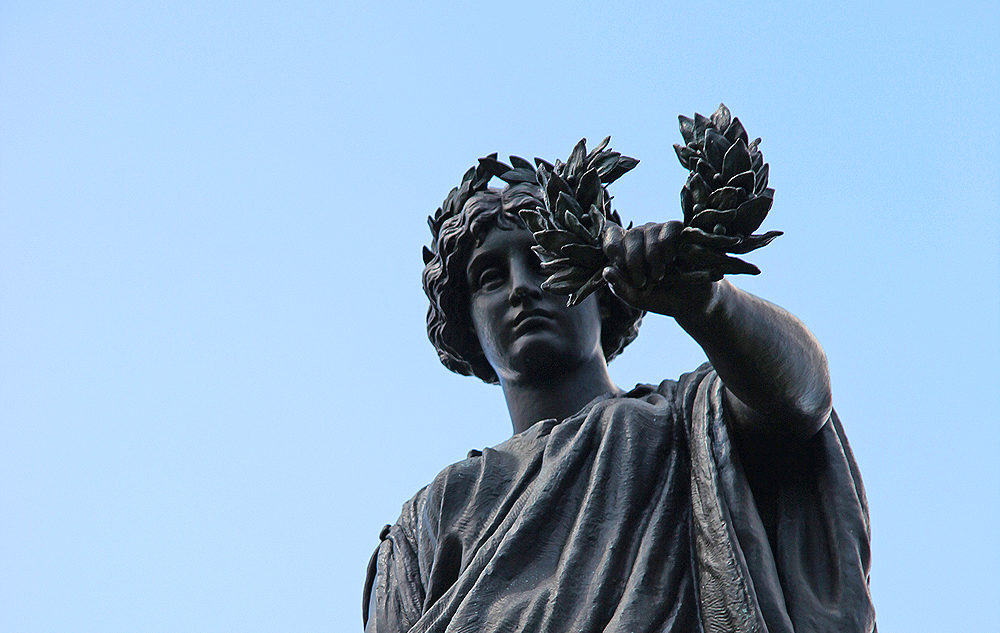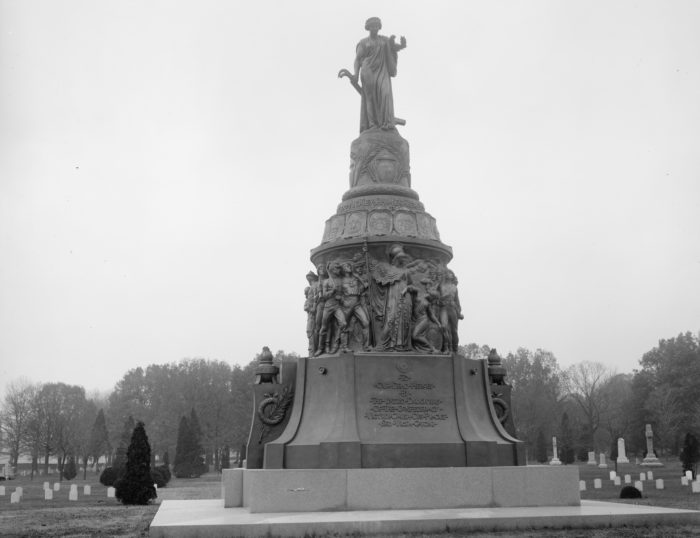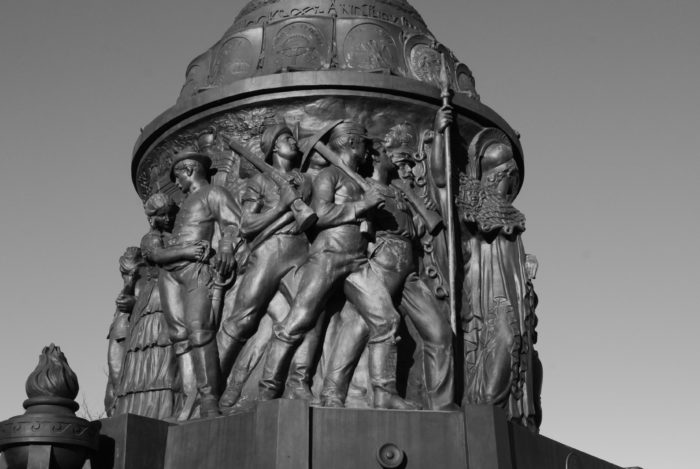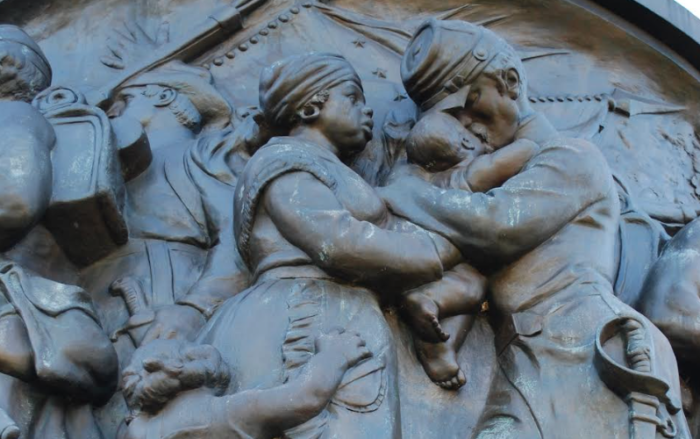Obedience to Duty
The Confederate Memorial is a notably ambitious and accomplished work of civic art. Woke iconoclasts want to tear it down.

The Croix Rouge Farm, located about 65 miles east of Paris, was the site of an infernal battle in July 1918. Regiments of the U.S. army’s famed Rainbow Division, which incorporated National Guard units from 26 states, attacked deeply entrenched, battle-hardened German troops backed by artillery firing high-explosive and poison-gas shells. The brunt of the fighting for the farm, much of it at bayonet point, was done by two battalions of the division’s 167th Infantry Regiment, which hailed from Alabama, with significant support from Iowa’s 168th. The farm was taken, the division’s chief of staff, Col. Douglas MacArthur, reported, “in a manner which for its gallantry I do not believe has been surpassed in military history.” One hundred sixty-two officers and men of the 167th were killed. The regiment’s 1st Battalion suffered a 65 percent casualty rate.
This brutal struggle took place four years after the erection of an elaborate, 32 ½ -foot-tall Confederate monument at Arlington National Cemetery. A congressionally authorized Pentagon “naming commission,” laser-focused on eliminating Confederate names or symbols from military property as if they were lethal pathogens, recently recommended its removal. The designer of this Confederate Memorial, one of the most remarkable sculptors the nation ever produced, intended it to confirm the reconciliation of North and South, despite the lingering bitterness left by the Civil War, while proclaiming the justice of the Confederate cause and the valor of the Southern warrior. He also conceived it as a funereal monument, erected on a rectangular, two-tiered granite plinth three feet tall with a bronze superstructure crowned by a larger-than-life-size female in classical drapery. She wears the olive wreath of peace on her head while one hand extends a laurel wreath not of victory but of virtue unscathed. Pressing a pruning hook against the stock of a plow with her other hand—imagery whose significance a public well versed in Holy Writ would readily have understood—she looks downward, toward graves below. Four hundred eight-two Confederate officers, enlisted men, wives, civilians and unknowns are buried in concentric rings around the monument.

Credit: Harris and Ewing, Library of Congress Prints and Photographs Division
On the drum beneath this idealized figure, four cinerary urns in flattened relief are inscribed with the years of the war’s duration, and below that Isaiah’s immortal words appear: “And they shall beat their swords into plowshares and their spears into pruning hooks.” Further down, the monument is ringed with the shields of fourteen states, the Confederacy’s eleven states plus three that contributed significant numbers of troops to its ranks: Missouri, Kentucky, and Maryland. The monument’s most controversial element is the frieze beneath the shields, with around thirty life-size figures in high relief, and others in low relief.
The frieze’s centerpiece is Athena, goddess of war and wisdom. Aligned with the crowning South figure, she lends her arm in support of a fainting draped female who clasps a shield, inscribed “The Constitution.” For the sculptor, Confederate veteran Moses Jacob Ezekiel (1844-1917), that meant the Constitution that supported states’ rights and free trade; for us it is far more likely to signify the Constitution that accommodated slavery. The fainting female also symbolizes the South—the old South. The trumpet blast of war is sounded next to these two figures while stalwart males symbolizing the service rendered by soldiers, sailors, sappers, and miners converge on them. Elsewhere on the frieze, a bride ties a sash with a sword around the waist of her beloved, a blacksmith who has forged his own sword bids his wife farewell, and a very young man receives his preacher father’s blessing as he takes leave of his parents. In two scenes which have been roundly denounced, a uniformed black manservant proudly marches off to war with his master, while a black mammy holds an infant up as its departing father, also in uniform, kisses it. His distraught little daughter clings to the mammy’s apron.
To say the monument’s portrayal of slavery is highly selective would be an understatement. And there is a contextualizing panel at the memorial site that makes sure that registers. Then again, monument makers generally aren’t interested in telling the whole story. Does the Arc de Triomphe, the most important honorific monument created in modern times, tell us the whole story of Napoleon’s war-mongering megalomania? Monument makers arrange their subject matter so as to portray historical events in an ideal, even mythopoeic light. Such portrayals are not devoid of truth because they’re telling us how designers and their audiences remembered events or wished to remember them. And in the Confederate Memorial’s case, remembrance and the provision of a funereal centerpiece for a Confederate burial plot were tied not only to national reconciliation but also to acknowledgment that the Lost Cause really was lost—once and for all.
On the front of the bronze structure’s base, beneath the Athena, the Latin inscription thus reads, “The victorious cause pleased the gods, but the vanquished pleased Cato”—Cato the Younger having been a key opponent of Julius Caesar, who prevailed against the former’s Republican faction in a Roman civil war not long before the birth of Christ. On the rear an inscription by a onetime Confederate chaplain reads: “Not for fame or reward/Not for fame or for rank/Not lured by ambition/Or goaded by necessity/But in simple/Obedience to duty/As they understood it/These men suffered all/Sacrificed all/Dared all—and died.” Is this inscription devoid of truth? I seriously doubt the brave men of the 167th Regiment would have thought so.
The Confederate Memorial’s funereal nature is reinforced by a bronze flaming urn, symbolizing eternal remembrance, on each flank. Ezekiel originally intended to have the memorial flanked by tripods with actual eternal flames. He is buried at the monument’s foot, in front of one of the bronze urns. There are likewise-situated burials at the other cardinal points: a veteran of the Confederate Navy, a veteran infantryman, and, finally, Marcus J. Wright, a rebel brigadier general who was wounded at Shiloh and went on to collect Confederate records for the U.S. Department of War. At the turn of the last century, Wright lobbied for burial of Confederate war dead at Arlington.
Moses Ezekiel was born in Richmond to Jewish parents of Sephardic descent. He entered the Virginia Military Institute in 1862 as its first Jewish cadet. He revered the institute’s most famous professor, Stonewall Jackson, and as a corporal of the Corps of Cadets stood watch by his casket in 1863 after Jackson received what proved a fatal wound from friendly fire at Chancellorsville. The following year, Ezekiel and 256 other VMI cadets were sent into battle outside the Shenandoah Valley village of New Market. Charging across a wheat field so muddy Ezekiel lost his shoes, the cadets braved artillery and musket fire and seized a Union cannon. They were instrumental in securing a notable Confederate victory, but suffered 57 casualties. Ezekiel’s roommate, Thomas Garland Jefferson, a great-grand-nephew of the third president, was shot in the chest. Ezekiel found lodgings for him and nursed him as best he could. Jefferson died two days after the battle at the age of 17.

Credit: Tim1965, Creative Commons.
Ezekiel had long showed an artistic bent, but after graduating from VMI in 1866 he thought of becoming a doctor. A change of heart and an extraordinary chain of events took him from the study of human anatomy and dissection of cadavers at the Medical College of Virginia in Richmond to private study with a Cincinnati sculptor, and from there to Berlin, where he won admission to the Royal Prussian Academy of Art. Years later he would establish his living quarters and studio in the supremely picturesque ruins of the Baths of Diocletian in Rome. There Ezekiel enjoyed a prolific career as a portrait sculptor and monument designer and became something of a celebrity. His experience of VMI and the Civil War largely defined his sense of himself and the monuments he aspired to create. The Arlington Cemetery commission came toward the end of his career and he considered it the most important he had ever received.
Ezekiel’s Confederate Memorial also marks the culmination of a series of events beginning with President McKinley’s declaration, during an 1898 speech in Atlanta, that the Federal government should assume responsibility for the care of Confederate graves. In 1906, Theodore Roosevelt’s secretary of War, William Howard Taft—one of many notables who had called on Ezekiel in Rome—welcomed a proposal for the erection of a Confederate memorial at Arlington. The United Daughters of the Confederacy entrusted its design to Ezekiel. Past and present national commanders of the Grand Army of the Republic, the fraternal association of Union Army veterans, spoke at the laying of the cornerstone and dedication of the monument (which took place in 1912 and 1914, respectively). One of those commanders had lost both legs below the knees in the Second Battle of Bull Run. President Woodrow Wilson spoke at the dedication.

Credit: Catesby Leigh
As I’ve said before, monuments are, among other things, chronological landmarks that tell us where we’ve been as a polity and a culture. Excoriating Ezekiel’s monument for advocating white supremacy is easy enough these days, but his frieze was a romantic evocation of the past, not a prescription for the future. And the Confederate Memorial reflects a political consensus that the Confederacy needed to be respectfully woven into the national story. That consensus was even more robustly symbolized when Arlington Memorial Bridge (1932) was erected across the Potomac, creating reciprocal vistas between the Lincoln Memorial and Arlington House, the Greek Revival mansion where Robert E. Lee had lived with his wife and children—and a portion of whose confiscated grounds the Lincoln administration had converted into what would become Arlington National Cemetery. The consensus had been encouraged by the participation of southern soldiers and officers in the Spanish-American War, and it would continue to have real-world ramifications, as the struggle for Croix Rouge Farm eloquently testifies.
It is true that African-Americans had no say in the forging of that consensus. It is true that our nation had a very long way to go on the road to a more perfect union when the Confederate Memorial was erected. But the notion that tearing it down will represent real progress toward racial justice is absurd. Like the other statuary vandalizations or removals of recent years, it will simply be another exercise in cheap “anti-racist” political theater serving to distract public attention from our welfare state’s ongoing failure to address serious social and economic problems afflicting millions of Americans—especially but not exclusively African-Americans—despite its consumption of trillions of taxpayer dollars since the 1960s.
As a culture, we were in some respects doing a lot better than we are now when Ezekiel’s monument was erected. The Confederate Memorial is a notably ambitious and accomplished work of civic art. It would be a very tall order to create as fine a monument in our day. The frieze figures convey an impressive sense of movement and purpose. They lack the formal depth of the finer achievements of the Prussian school, one of Europe’s most rigorous when Ezekiel was enrolled at the Berlin academy, but their arrangement in a circular formation required considerable skill. I wonder whether any American contemporary of Ezekiel’s could have displayed such technical competence. It’s even more doubtful any artist could do so now—especially without the aid of a computer.

Credit: Catesby Leigh
The Pentagon commission, however, wasn’t interested in the Confederate Memorial’s artistic significance. And its recommendation that the memorial’s bronze superstructure be dismantled and removed—the granite plinth should be left in place to avoid disturbance of the graves, according to the report it issued on September 30—is looking like a done deal. Secretary of Defense Lloyd Austin approved the commission’s recommendations in October. When I visited late last month, I found the roadway encircling the cemetery’s Confederate section strewn with cinder gravel and surrounded on both sides by temporary fencing. Even so, the monument’s removal could be delayed for some time by a historic preservation review. This is because the Confederate Memorial is categorized as a “contributing resource” to the cemetery, which is listed on the National Register of Historic Places.
Subscribe Today
Get daily emails in your inbox
Republican politicians have routinely failed to denounce woke iconoclasm since the George Floyd riots broke out in 2020. Arlington National Cemetery is located in Virginia, and it would be refreshing to see the state’s Republican governor, Glenn Youngkin, take a vigorous stand against the outrageous removal of a historic funerary monument. Congressional Republicans should also do whatever they can to derail a removal project that won’t come cheap. Can the Pentagon seriously tell us it doesn’t have more worthwhile priorities to attend to?
Our “conservative” worthies might also have a look at a recent Wall Street Journal editorial warning that Americans’ “fading trust” in their institutions now extends to the military. An annual survey by the Reagan Institute showed 48 percent of the public having “a great deal of confidence” in our armed services, down from 70 percent in 2018. Pew Research has noted the same trend. Half the Reagan Institute survey’s respondents cited “so-called ‘woke’ practices undermin[ing] military effectiveness,” slightly more than the number suspecting the armed services of harboring right-wing crazies. At the same time, it’s no secret that the services—especially the army—are having a harder time meeting recruitment quotas. Wokeness is not the only reason, but it sure isn’t helping, given that the military’s reputation among conservatives is in steep decline. Amputating an important part of American history—the post-bellum political reconciliation between North and South that reflected, among other things, recognition of the valor of the Confederate warrior and the contribution his progeny could be expected to make to the nation’s future defense—is an incredibly dumb idea. Surely there are more sensible ways to honor the contributions made by our nation’s black servicemen. Hopefully it’s not asking too much of the saner elements of our political class to give that possibility some serious consideration.
Author's Update (12/14/22): Since this story was posted a spokeswoman for Arlington National Cemetery informed me the temporary fencing and cinder gravel around the Confederate section are for roadway resurfacing necessitated by utility work and have nothing to do with Ezekiel's memorial.
Comments